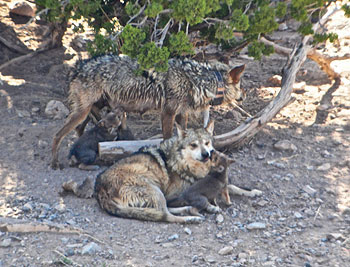Scientific Name
Canis lupus baileyi
Also Called: Mexican Wolf or Lobo
Description
Of the five subspecies of gray wolves in North America, the Mexican Wolf is the smallest and the most endangered gray wolf in North America. The color of its coat is usually a mix of brown, gray, rust, and tan. The color of its tail, legs, and ears is often more black.
Food
In the wild, the Mexican Wolf mainly eats deer; however, it sometimes will also small mammals such as rabbits and javelina as well as larger prey such as elk, pronghorns, and livestock.
Habitat
Mexican wolves native habitat is Mexico, west Texas, south New Mexico, and southeast Arizona. However, there are very few in the wild today due to hunting and trapping in the mid 1900’s. Due to a combined effort by Mexico and the United States in 1998, captive bred Mexican Wolves have been released into special areas in an attempt to increase their numbers.
Social Structure
Mexican wolves live in packs, which typically consist of 5 or 6 individual wolves (usually 2 adults and their offspring from the current year). Once together, a pair of adult Mexican Wolves usually stay together for life. Individual wolf packs rarely come in conflict with one another as their boundaries are well marked and understood by all through the use of scent marking and howling.
Birth & Offspring

Mexican wolves typically breed in either February or March and produce pups after a gestation period of around 63 days. Litters usually range from 4 to 6 pups.
Senses
Mexican Wolves hunt using their excellent hearing and smell. These two senses also help them communicate with other wolves through howls, barks, growls, and whimpers. In addition, body language is used to communicate through the use of facial expressions, movement, and body posture.

Lydia King is a huge animal lover and has always been fascinated with learning about the animal kingdom. She enjoys writing about anything animal related from scientific information about rare species to animal references in pop culture.












